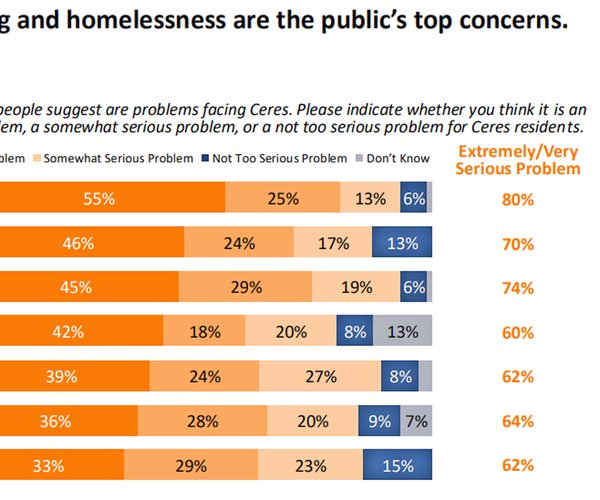The planned Ceres station for the Altamont Corridor Express (ACE) train is now in its preliminary design stage.
City Manager Tom Westbrook said he was updated recently by Dan Leavett, manager of Regional Initiatives for the San Joaquin Regional Rail Commission.
“They said that they would be contacting me in the next couple of weeks to a month to sit down and talk about the preliminary design,” said Westbrook. “Once I have that I’ll probably just shoot it in front of the council so that they can see what that is going to look like.”
Talk of the ACE train line being extended to Modesto, Ceres, Turlock and ultimately Merced has been taking place since 2014. Currently the closest ACE train access to Ceres is the Manteca/Lathrop station although there are stations in Stockton and Tracy. The ACE extension to Ceres looked more promising after the passage of Measure L, the half-cent sales tax hike in Stanislaus County, and the state’s passage of SB 1. Key in passing the $52 billion transportation plan, Senate Bill 1, was then state Senator Anthony Cannella who wrestled a pledge of $400 million to the ACE project extension to Merced.
Ceres city officials secured a promise to add a stop platform in Ceres. It will be located between the southbound lanes of Highway 99 and Railroad Avenue which will be accessible only from the east side of the freeway. Users would park in a future parking area along the wall of the raised part of the freeway and walk underneath the existing overpass. The city added safety lighting in downtown in anticipation of the station. Officials also want the under the freeway pedestrian tunnel to be safe and well lit.
Currently the train runs four trips per day between Stockton and the Bay Area but plans call for an extension to Ceres with stop platforms in downtown Manteca, Ripon, Modesto and Ceres.
Rosa Park, director the Stanislaus Council of Governments (StanCOG) said the project should not be imperiled by the looming state budget.
“That funding is there and dedicated for these uses only,” said Park. “So it’s like you can divert it and put it in the general fund and put it somewhere else.”
She said she is more concerned about how the COVID-19 pandemic will cause a shortage of future sales tax money to support ACE and other transit services.
“Will we have enough money for all of those things? That’s the concern.”
She said the first hurdle will be to get improvements made to the existing historic Modesto train station. That’s expected to be take place by the end of 2021. Once that station is completed, the ACE train should be extended to Ceres within three to four months.
“The only thing that would impact the schedule is if Modesto can’t get the station done in their timeline.”
Park said she remains hopeful that Ceres will see the service by 2022.
Ceres has already begun improving lighting in the Whitmore Park area where riders are expected to park and walk to the ACE train platform.
Diagonal parking for 116 vehicles will be offered along El Camino Avenue from Central Avenue to the southern point of Whitmore Park. To create room for parking spaces just west of Whitmore Park, a new concrete retaining wall must be constructed shouldering the raised freeway. Conceptual drawings have the walls painted with a mural as part of the station design. Pedestrians will be able to access the train platform via two new pedestrian paths crossing under the freeway. A traffic signal will be installed on the southbound Hwy. 99 off-ramp at El Camino Avenue.
The station platform – measuring about 15 feet wide and 1,000 feet long – will feature passenger amenities and safety features, such as patron shelters with benches and map boxes, ticket validation machines, street lamps, guardrails, security equipment, and emergency call box stations. A 1,200-foot-long fence would be constructed between the existing main track and the second main track (which would function as the station track) in the vicinity of the station platform.
Modesto would also get an ACE train stop at the existing transit station on Ninth Street. Ceres would be the end of the southern extension until the second phase takes it to Turlock and Merced by 2026. Until a Merced line is extended, riders will be able to ride to Ceres and take a bus to Merced.
During the interim period when Ceres is the farthest point south, evening trains will be stored at a layover facility south of Service Road near the grain towers. The temporary layover facility in Ceres would discontinue pending the completion of the extension to Merced and a permanent layover facility in Merced.
Vierra has been staying abreast of the ACE train development since he appointed himself to represent Ceres on the Stanislaus Council of Governments (StanCOG) last August. He understands that initially the ACE train would only run on higher ridership days.
Chris Kay, outreach and marketing manager for the San Joaquin Regional Rail Commission, said that ACE currently carries 1.3 million passengers a year and “makes a huge difference for people going from the Central Valley to the Bay Area. It’s a good way to bring jobs.”
Vierra said he’s hopeful the ACE train is utilized to eliminate stressful driving for those who live in Ceres and work in the Bay Area or those who want to access Bay Area tourist spots and attend games.
A feature of the train is Wi-Fi connection so that professionals can work on laptops while they ride to the workplace.
ACE currently operates four westbound trains in the morning from Stockton to San Jose and four eastbound trains in the afternoon from San Jose to Stockton during weekdays only. There are 10 ACE stations along the existing route (from west to east): San Jose Diridon, Santa Clara and Great America stations in Santa Clara County; Fremont, Pleasanton, Livermore, and Vasco Road stations in Alameda County; and Tracy, Lathrop/Manteca, and Stockton stations in San Joaquin County. ACE 3currently does not operate on weekends.
ACE trains usually consist of one diesel locomotive and five 4 to seven bi-level passenger coaches and can reach a top speed of 79 miles per hour.







